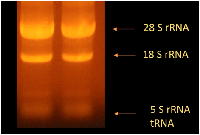Detection of cytosolic tRNA in mammal by Northern blot analysis
DOI:
https://doi.org/10.3329/bjp.v12i3.32501Keywords:
Northern Blot, RNA, rRNAAbstract
Out of entire cascade of technologies and strategies, Northern blot assay remains the most preferential approach for immediate and accurate evaluation of expressed RNA species. However, an abundance of tRNAs species under physiological conditions compared to other small RNAs makes it difficult to accurately evaluate their transcriptional alterations through traditional Northern blot assay. Here, we describe an efficient protocol for detecting subtle alterations in tRNA species in mammals by a modified Northern blot assay. This report also compares the chemical versus UV-based crosslinking of tRNA species to the surface of solid supports.
Video Clip of Methodology:
Detection of cytosolic tRNA in mammal by Northern blot analysis: 16 min 55 sec Full Screen Alternate
Downloads
211
169
References
Alwine JC, Kemp DJ, Stark GR. Method for detection of specific RNAs in agarose gels by transfer to diazobenzyloxymethyl-paper and hybridization with DNA probes. Proc Natl Acad Sci USA. 1977; 74: 5350-54.
Gesteland RF, Cech TR, Atkins JF. (eds.) The RNA World. 3rd ed. Cold Spring Harbor Laboratory Press. 2006.
Laneve P, Giangrande A. Enhanced Northern blot detection of small RNA species in Drosophila melanogaster. J Vis Exp. 2014; 9: e51814.
Wei Y. Northern blot of tRNA in yeast. Bio-protocol. 2013; 3: e464.

Downloads
Published
How to Cite
Issue
Section
License
Authors who publish with this journal agree to the following terms:
- Authors retain copyright and grant the journal right of first publication with the work simultaneously licensed under a Creative Commons Attribution License that allows others to share the work with an acknowledgement of the work's authorship and initial publication in this journal.
- Authors are able to enter into separate, additional contractual arrangements for the non-exclusive distribution of the journal's published version of the work (e.g., post it to an institutional repository or publish it in a book), with an acknowledgement of its initial publication in this journal.
- Authors are permitted and encouraged to post their work online (e.g., in institutional repositories or on their website) prior to and during the submission process, as it can lead to productive exchanges, as well as earlier and greater citation of published work (See The Effect of Open Access).
